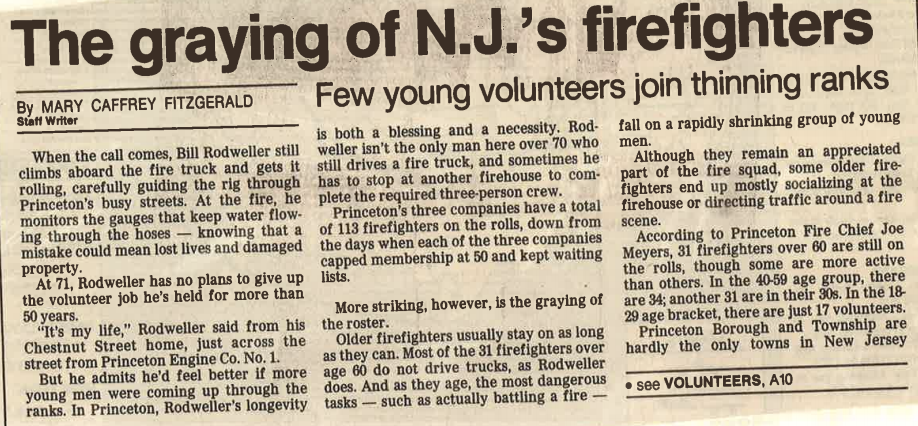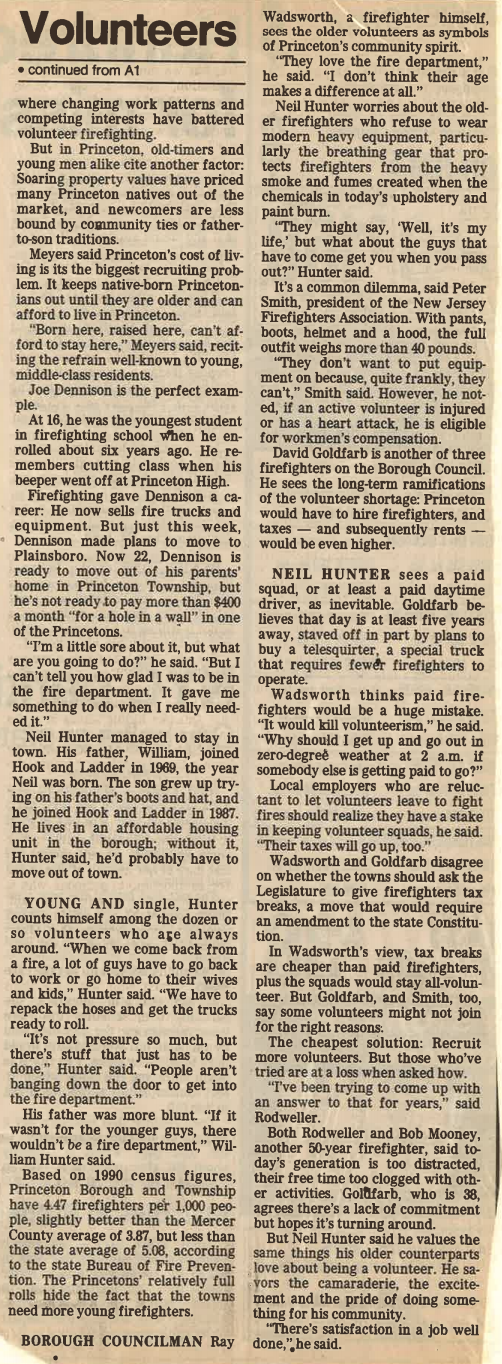
November 12, 1992
The graying of N.J.’s firefighters
By Mary Caffrey Fitzgerald
Staff Writer
When the call comes, Bill Rodweller still climbs aboard the fire truck and gets it rolling, carefully guiding the rig through Princeton’s busy streets. At the fire, he monitors the gauges that keep water flow-ing through the hoses — knowing that a mistake could mean lost lives and damaged property.
At 71, Rodweller has no plans to give up the volunteer job he’s held for more than 50 years.
“It’s my life,” Rodweller said from his Chestnut Street home, just across the street from Princeton Engine Co. No. 1.
But he admits he’d feel better if more young men were coming up through the ranks. In Princeton, Rodweller’s longevity is both a blessing and a necessity. Rodweller isn’t the only man here over 70 who still drives a fire truck, and sometimes he has to stop at another firehouse to complete the required three-person crew.
Princeton’s three companies have a total of 113 firefighters on the rolls, down from the days when each of the three companies capped membership at 50 and kept waiting lists.
More striking, however, is the graying of the roster. Older firefighters usually stay on as long as they can. Most of the 31 firefighters over age 60 do not drive trucks, as Rodweller does. And as they age, the most dangerous tasks — such as actually battling a fire — fall on a rapidly shrinking group of young men.
Although they remain an appreciated part of the fire squad, some older fire-fighters end up mostly socializing at the firehouse or directing traffic around a fire scene.
According to Princeton Fire Chief Joe Meyers, 31 firefighters over 60 are still on the rolls, though some are more active than others. In the 40-59 age group, there are 34; another 31 are in their 30s. In the 18-28 age bracket, there are just 17 volunteers.
Princeton Borough and Township are hardly the only towns in New Jersey

where changing work patterns and competing interests have battered volunteer firefighting.
But in Princeton. old-timers and young men alike cite another factor: Soaring property values have priced many Princeton natives out of the market, and newcomers are less bound by community ties or father-to-son traditions.
Meyers said Princeton’s cost of liv-ing is its the biggest recruiting problem. It keeps native-born Princeton-ians out until they are older and can afford to live in Princeton.
“Born here, raised here, can’t afford to stay here,” Meyers said, reciting the refrain well-known to young, middle-class residents.
Joe Dennison is the perfect example.
At 16, he was the youngest student in firefighting school When he en-rolled about six years ago. He re-members cutting class when his beeper went off at Princeton High.
Firefighting gave Dennison a career: He now sells fire trucks and equipment. But just this week, Dennison made plans to move to Plainsboro. Now 22, Dennison is ready to move out of his parents’ home in Princeton Township, but he’s not ready to pay more than $400 a month ”for a hole in a wall” in one of the Princetons.
“I’m a little sore about it, but what are you going to do?” he said. “But I can’t tell you how glad I was to be in the fire department. It gave me something to do when I really needed it.”
Neil Hunter managed to stay in town. His father, William, joined Hook and Ladder in 1969, the year Neil was born. The son grew up try-ing on his father’s boots and hat, and he joined Hook and Ladder in 1987. He lives in an affordable housing unit in the borough; without it, Hunter said, he’d probably have to move out of town.
YOUNG AND single, Hunter counts himself among the dozen or so volunteers who ace always around. “When we come back from a fire, a lot of guys have to go back to work or go home to their wives and kids,” Hunter said. “We have to repack the hoses and get the trucks ready to roll.
“It’s not pressure so much, but there’s stuff that just has to be done,” Hunter said. “People aren’t banging down the door to get into the fire department.”
His father was more blunt. “If it wasn’t for the younger guys, there wouldn’t be a fire department,” William Hunter said.
Based on 1990 census figures, Princeton Borough and Township have 4.47 firefighters pet 1,000 people, slightly better than the Mercer County average of 3.87, but less than the state average of 5.08, according to the state Bureau of Fire Prevention. The Princetons’ relatively full rolls hide the fact that the towns need more young firefighters.
BOROUGH COUNCILMAN Ray Wadsworth, a firefighter himself, sees the older volunteers as symbols of Princeton’s community spirit.
“They love the fire department,” he said. “I don’t think their age makes a difference at all.”
Neil Hunter worries about the old-er firefighters who refuse to wear modern heavy equipment, particularly the breathing gear that protects firefighters from the heavy smoke and fumes created when the chemicals in today’s upholstery and paint burn.
“They might say, ‘Well, it’s my life,’ but what about the guys that have to come get you when you pass out?” Hunter said.
It’s a common dilemma, said Peter Smith, president of the New Jersey Firefighters Association. With pants, boots, helmet and a hood, the full outfit weighs more than 40 pounds.
“They don’t want to put equipment on because, quite frankly, they can’t,” Smith said. However, he not-ed, if an active volunteer is injured or has a heart attack, he is eligible for workmen’s compensation.
David Goldfarb is another of three firefighters on the Borough Council. He sees the long-term ramifications of the volunteer shortage: Princeton would have to hire firefighters, and taxes — and subsequently rents —would be even higher.
NEIL HUNTER sees a paid squad, or at least a paid daytime driver, as inevitable. Goldfarb believes that day is at least five years away, staved off in part by plans to buy a telesquirter, a special truck that requires fewer firefighters to operate.
Wadsworth thinks paid fire-fighters would be a huge mistake. “It would kill volunteerism,” he said. “Why should I get up and go out in zero-degree weather at 2 a.m. if somebody else is getting paid to go?”
Local employers who are reluctant to let volunteers leave to fight fires should realize they have a stake in keeping volunteer squads, he said. “Their taxes will go up, too.”
Wadsworth and Goldfarb disagree on whether the towns should ask the Legislature to give firefighters tax breaks, a move that would require an amendment to the state Constitution.
In Wadsworth’s view, tax breaks are cheaper than paid firefighters, plus the squads would stay all volunteer. But Goldfarb, and Smith, too, say some volunteers might not join for the right reasons.
The cheapest solution: Recruit more volunteers. But those who’ve tried are at a loss when asked how.
“I’ve been trying to come up with an answer to that for years,” said Rodweller.
Both Rodweller and Bob Mooney, another 50-year firefighter, said to-day’s generation is too distracted, their free time too clogged with other activities. Goldfarb, who is 38, agrees there’s a lack of commitment but hopes it’s turning around.
But Neil Hunter said he values the same things his older counterparts love about being a volunteer. He savors the camaraderie, the excitement and the pride of doing some-thing for his community.
“There’s satisfaction in a job well done,”he said.